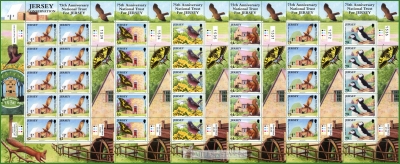-


Subject:
64 pence. Le Moulin de Quétivel** and The Red Squirrel***
Additional:
*Jersey is well known for its abundance of natural and historical splendour and conservation has, for many years, been a high priority for the residents of the Island. The National Trust for Jersey is an independent and charitable organisation dedicated to preserving and safeguarding areas of historic, aesthetic and environmental interest for the benefit of the entire Island. In 2011, the National Trust for Jersey will be celebrating its 75th Anniversary and Jersey Post is delighted to join in the celebrations by issuing a set of stamps which depict both wildlife and buildings which hold particular significance for the organisation.
The Trust is now the island's largest private land owner, caring for over 130 sites
**About Le Moulin de Quétivel you can read at description of the release of 2009
***The Red Squirrel or Eurasian red squirrel (Sciurus vulgaris) - the Island’s favourite animal, can be seen foraging throughout the treetop canopies in the adjoining woodland footpaths.
The red squirrel is a species of tree squirrel in the genus Sciurus common throughout Eurasia.
The red squirrel has a typical head-and-body length of 19 to 23 cm (7.5 to 9 in), a tail length of 15 to 20 cm (5.9 to 7.9 in) and a mass of 250 to 340 g (8.8 to 12 oz). It is not sexually dimorphic, as males and females are the same size. The red squirrel is somewhat smaller than the eastern grey squirrel which has a head-and-body length of 25 to 30 cm (9.5 to 12 in) and weighs between 400 and 800 g (14 oz to 1.8 lb). It is thought that the long tail helps the squirrel to balance and steer when jumping from tree to tree and running along branches and may keep the animal warm during sleep.
The coat of the red squirrel varies in colour with time of year and location. There are several different coat colour morphs ranging from black to red. Red coats are most common in Great Britain; in other parts of Europe and Asia different coat colours co-exist within populations, much like hair colour in some human populations. The underside of the squirrel is always white-cream in colour. The red squirrel sheds its coat twice a year, switching from a thinner summer coat to a thicker, darker winter coat with noticeably larger ear-tufts (a prominent distinguishing feature of this species) between August and November. A lighter, redder overall coat colour, along with the larger ear-tufts (in adults) and much smaller size, distinguish the Eurasian red squirrel from the American eastern grey squirrel.
The red squirrel, like most tree squirrels, has sharp, curved claws to enable it to climb and descend broad tree trunks, thin branches and even house walls. Its strong hind legs enable it to leap gaps between trees.The red squirrel also has the ability to swim.This information has been taken from Wikipedia
Stamps issued in sheets with the same design. In the lower right corner of each sheet is given big picture of mill (see 2nd picture).
Size (of sheet, booklet) mm: 143x206
75 years of the National Trust for Jersey
Jersey 2011.08.03
In issue: Stamp(s): 6
Issued in: sheets of 10 (2*5) stamps